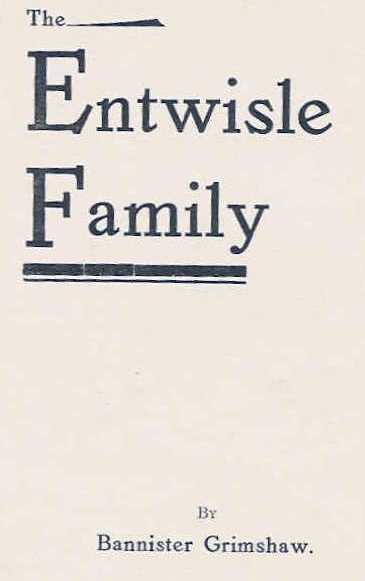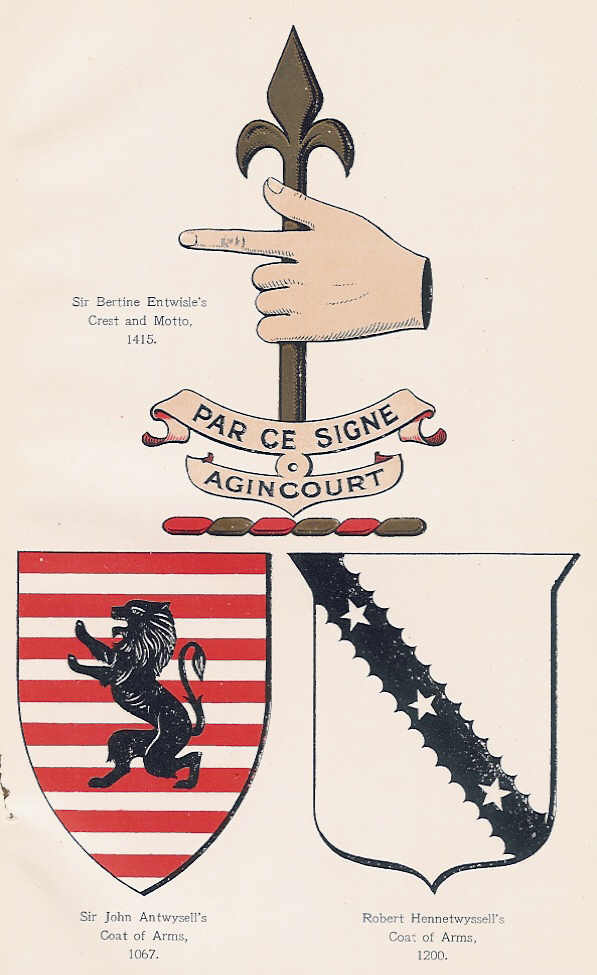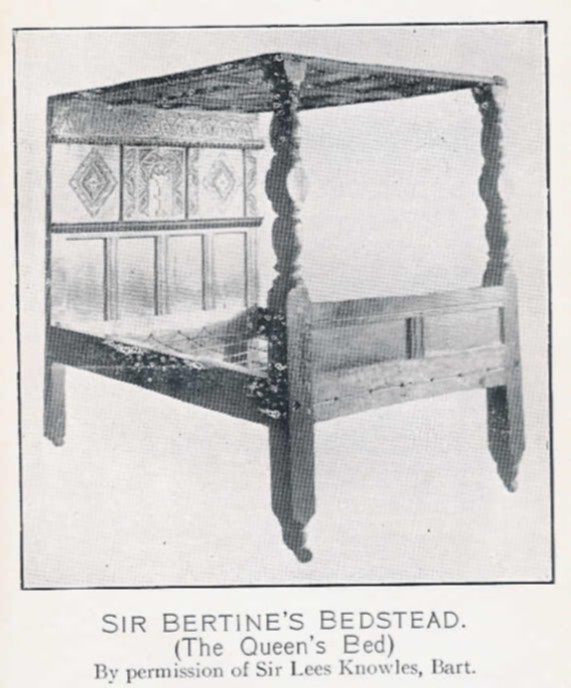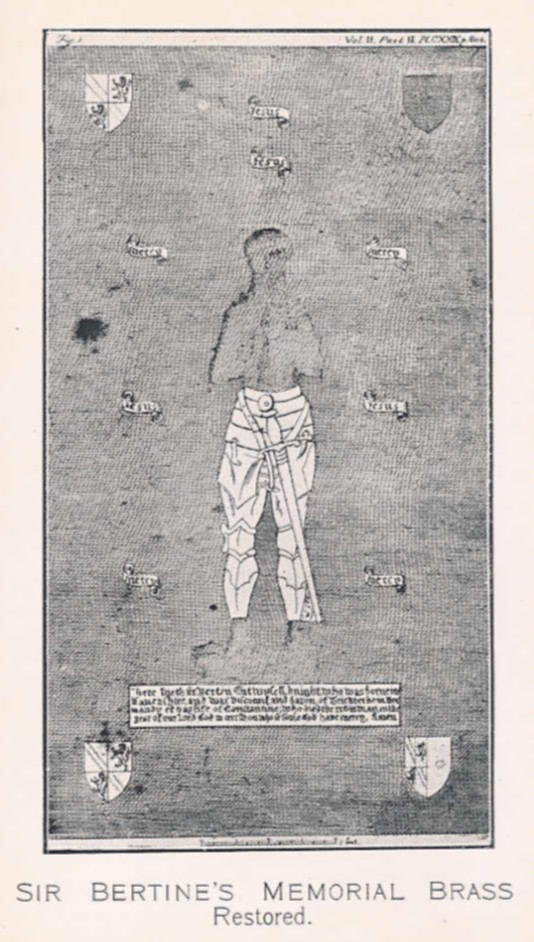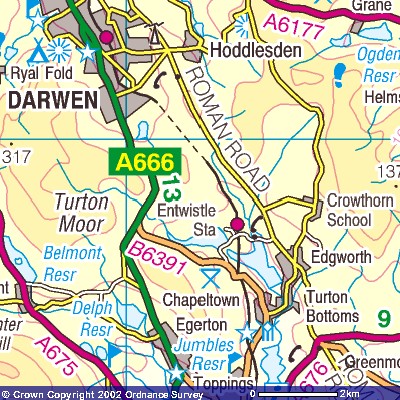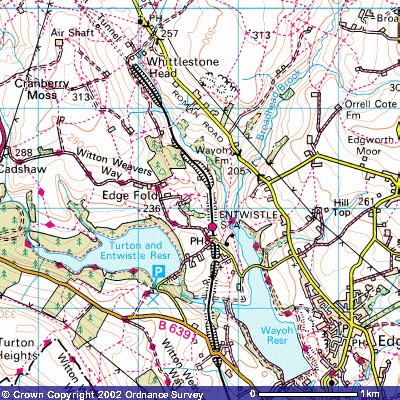Bannister Grimshaw’s “The Entwisle Family”
A Family History Prepared for a Friend

Image from Front Cover of Bannister’s Book
Bannister Grimshaw, an amateur historian, wrote a short book on the Entwistle family history1, which was published in 1924. Inasmuch as the book was dedicated to W.A. Entwistle, Esq., “as a small recognition of his friendship to the Author”, it appears that Bannisters motive in writing the book was to please a friend. However, the book was based on information apparently compiled in a vain attempt by members of the Entwistle family to regain the estate the family had lost centuries earlier, so there may have been a financial motive as well.
Nothing is known of Bannister Grimshaw or his family history, but he lived at Entwistle, which is located a few miles of the original Grimshaw location in Eccleshill.
Contents
Cover and Cover Page of Bannisters Book
Information on Bannisters Book from the Entwistle Family History Website
Entwistle Family Coats of Arms and Crest
Website Credits
Thanks go to the creators of the website of the Entwisle Family History Association, from which much of the information on “The Entwisle Family” presented on this webpage is taken.
Cover and Cover Page of Bannisters Book
An image from the cover of “The Entwisle Family” is shown at the top of this webpage. The book’s cover page is shown in Figure 1.
Figure 1. Image of the cover page of Bannister Grimshaws book
Information on Bannisters Book from the Entwistle Family History Website
The website of the Entwistle Family History Association (see Figure 2) contains a good deal of information on Bannisters book; the website address is shown below:
Figure 2. Banner taken from the Entwistle Family History Association
The website provides the following background information on the Association:
The Origins of the Association:
As a result of an appeal in the Lancashire Family History Society Magazine, for someone to co-ordinate research locally into the Entwistle family, Barbara Nightingale (of Darwen, Lancashire) and Tim Entwistle (of Great Harwood, Lancashire) decided to look into the possibility of setting up an Entwistle Family Society.
They envisaged a society in which members could get together from time to time, to get to know each other, and to exchange experiences and information etc.
A further aim would be to put people researching the Entwistles in the same part of the country, or indeed in other parts of the world, in touch with each other.
An Inaugural Meeting was held in Blackburn , Lancashire in September 1999 attended by 21 people from all parts of the UK. At this meeting it was decided that the society should become: The Entwistle Family History Association (EFHA)
By October 2002 (AGM) membership had reached 150 world-wide.
Why not join this growing happy clan and keep up-to-date on the latest research and information about your ancestry – The Entwistles of Lancashire, UK?
Benefits of Membership include:
A quarterly newsletter “Twissle Times” containing interesting anecdoates and information about the family, its members and its history, requests for help and offers of help, unwanted certificates etc.
A list of members interests showing in which countries, counties and towns other members are researching. Brief details of each member’s ancestry and records held by them are also included. This latter has enabled several members to make links with others researching the same branch of the family.
Gives members access to our extensive data base and growing central Entwistle Family record system using several volumes of printed material, data bases and CD based records.
We can provide help with research particularly to those members who are not resident in the UK.
Opportunities to meet other Entwistle Family researchers and family members from all parts of the UK and World-wide. The EFHA now organises an informal social gathering every spring and an AGM every October.
The objects of the Association shall be:
a) to advance the study of Family History of persons researching the name of Entwistle and its variants.
b) to promote the accessibility of data concerning the name “Entwistle” and its variants to members of the Association.
c) to provide a forum for members to meet from time to time to get to know each other and exchange information.
d) to receive contributions by way of subscription, donation or otherwise in order to raise funds for the objects stated above, excepting that the Association shall in no way undertake any permanent trading or commercial activity deemed detrimental to its primary objects or status.
In addition, the following background information on “The Entwistle Family” is provided:
The story behind the book
As Peter Stanford says in his review of the book (originally published in Twisstle Times, summer 2000) the family’s history could hardly have been bettered by any fictional work: “It has everything – a hero, the gallant Sir Bertine Entwisle; a black sheep, the weak willed George Entwisle; and a villain, the odious Thurston Tyldesley…”
It is the present generation’s good fortune that Grimshaw saw fit to publish his notes and records on this otherwise little known subject, as he says himself, “…in the hope of creating an interest in a very ancient and notable Lancashire family.”
However, the book is now quite rare and it is unlikely that most Entwistles will be able to obtain a copy. With the miracle of the Internet, something Grimshaw could hardly have imagined back in 1924, we are now able to share his words and pictures, his book and his interests, with Entwistles and their relatives, world-wide.
The Grimshaw book was published in 1924 by the then Accrington Gazette Company Limited, 88 Abbey Street Accrington, Lancashire . The paper merged with the East Lancashire Sentinel and continued in existence as a free paper until just prior to WW2.
The book was compiled by Bannister Grimshaw, an amateur historian and a resident of Entwistle, from a collection of notes and jottings made through his interest in the area and the family.
Much of the information was gathered together by some Entwistle claimants and Bannister Grimshaw in a vain attempt to re-gain control of the The Entwistle family estate which had been lost to the family over 400 years earlier.
The Entwistle Estate had been considerable, with land and property also in Edgworth, Turton, Radcliffe, Bolton , Withington, Chorlton, Ardwick, Ancoats, Rusholme, and Manchester.
The claim was not pursued in the end – read the book and Peter Stanford’s review to find out why!
We intend to publish the book here in its entirety, for the benefit of all Entwistles and historical researchers around the world. This may take a little time to complete.
The book is not divided into convenient chapters so here we have split the book up into manageable sections with page numbers given. The book is illustrated throughout, and copies of the images will be provided here.
To the best of our knowledge and belief this publication is now (due to lapse of time) copyright free. Further, we publish here not for financial gain but for the benefit of Entwistles and researchers everywhere. Should anyone dispute this please contact us.
Finally, the first 11+ pages of the book are included on the website; the text is reproduced below.
The Entwis(t)le Family
By Bannister Grimshaw
1924
Printed and Published by
The Accrington Gazette Co., Ltd.
88 Abbey Street.
Dedication: To W A Entwistle Esq., This Book is Dedicated, as a small recognition of his friendship to the Author.
Forward.
This little book makes no claim to be a history of the Entwis(t)le family. It is merely a compilation of notes and records the writer has collected from many sources in the hope that they may prove of service by creating an interest in the very ancient and notable Lancashire family; revive the dormant pride of ancestry in present-day representatives, and prove of some little service to a future historian.
The 1923 quest for evidences for the purpose of discovering if there were any grounds on which the family could base a claim for the recovery of their traditional lost inheritance, proved that there is a vast quantity of very interesting and ancient documents, etc., held by the family’s modern representatives scattered over a wide area, a discovery mainly due to the “keen scent” and unflagging activities of Mrs. Marr, of Weaste, who seems to have invaded every creek and cranny in the country for evidence. It is hoped her labours may find reward in a future volume.
The effect of this knowledge was to create in Mr. W A Entwisle – one of the committee – the laudable ambition that there should be an annual gathering of the clans to spend a social evening together with the dual object of maintaining fraternal intercourse and placing on permanent record such historical family records, traditions, etc, as they may possess.
It is with this object in view that he very generously offered to be financially responsible for the publications of this little volume, should its merits fail to attract the necessary support of the family – on whom it is obviously mainly dependent for its sales.
Notes are ever incomplete, but they are always useful as bases for enlargement and research. There is the bare mention, for instance, of two brothers: Bertine Entwisle, Vice-Chancellor of the Duchy of Lancaster; and Edmund, Dean of Chester. Their life stories must be teeming with interest; yet they have not been recorded. There are many others – past and present – well worthy a writer’s attention.
It is indisputable that for nigh on a thousand years the family has been producing modest men, doers of noble deeds – but unfortunately, unknown, unsuspected or unappreciated by their own posterity.
The Entwistle Family – Section One pages 7- 11
THE ENTWIS(T)LE FAMILY is certainly of very ancient and honourable origin. The name has been spelt in many ways as will be seen as we proceed, but does not constitute a complete list. In these days some people spell it Entwistle. The second “t” was first included about 1750. As a surname it is common throughout Lancashire , and one might say it is known in every part of the English-speaking world. This is somewhat singular when we note the rarity of the use as a surname of neighbouring township’s names as Edgworth, Turton, Quarlton, Darwen, etc., which are much more ancient as place- names, and were in fairly common use as personal names in the district in a long bye-gone day. From this we may gather that the family made use of a hereditary surname throughout a period when fixity of family names was not in general use; that they were- in settled occupation in and around their ancestral home over a very extended period, and that they have never been responsible for a declining birth-rate.
As regards its status in the nation, it may be described as obscure; obscure in the sense of jewels mislaid, hidden or bedimmed by a dust of ages of forgetfulness and neglect. I am hoping to be able – not to refurbish, but to re-expose a few of the gems in the family crown; to provide evidences proving the family to be of notable Norman origin; that they have ever been loyal to – and have ever honourably rendered their best services to their adopted country, and that its heroes are worthy of having their names inscribed on the fairest page of our national history. French writers seem to have honoured them as foremen; whilst in England, Lancashire , the township which bears their name, even their own kith and kin have paid neither homage nor tribute in any form to their honour and memory.
The three extracts following are from very ancient documents which are said to have been preserved in the British Museum for a very long time. From the Whalley Pedigree we learn that “Wyramarus Walley had by gift of William, Bastard Duke of Normandy in the seconde year of his reigne which was in the yeare of our Lord God Anno Dom.i 1067 for his servis done at the Battlel of Hastings, the Lordship of Whalley in the Wepontake of Blackburn in the County of Lancastershyre. He married and had issue Eustas who married Godytha the daughter of Sir John Antwisel.”
From the Upton pedigree we gather that “Sir Bryan Upton married Tiburia, the daughter of Sir John Antwisel.” Again, in the Stansfield Pedigree ( Stansfield, near Rochdale) , we are informed that “Wyons Maryons, Lord of Stansfield, came from Normandy with William the Conqueror and had issue Jordan, who married the daughter of Sir John Townley, of Townley, County Lancaster; they had issue a son and heir, John de Stansfield, who married Elizabeth, a daughter of Thomas Entwissel.” This was in the rein of William Rufus. We thus find the sons of the three more or less important Norman families marrying into the Entwistle family.
Whether the brides and bridegrooms were real or fictitious, the records tend to prove the high esteem in which the Entwisle family was held in the days of long ago, otherwise we should not find these influential Norman families evidently anxious to perpetuate their close association with the bride’s family. In very many ancient genealogical charts the bride’s family name is ignored. We all, of course, are well aware that pedigrees are none to reliable, but that does not in the least affect the obvious popularity of the Entwisle family for stock purposes, where the best blood is essential.
What evidences can we find to prove that the brides were Norman and not Saxon heiresses? No Norman gentleman was permitted to marry a Saxon lady without the sanction of the King, and these licenses were non too readily granted. The majority of the Saxsons’ estates were confiscated and bestowed upon William’s followers, and impoverished Saxon ladies would not be likely to be sought in marriage, and there would obviously be racial hatred betwixt usurper and victim bitter enough to prove an un-surmountable barrier to inter-marriage for several generations.
Dealing with the fathers of the brides – John and Thomas Entwisle – the late Mr. Alfred Burton, on of the founders of the Lancashire & Cheshire Antiquarian Society, has pointed out that the Saxons never used Apostolic names as Christian names. It therefore seems evident these two men were Norman adherents of William of Normandy.
The absence of the de (of) in connection with their name is due to their being in possession of a hereditary surname, and partly to the fact that Entwisle was not an official place name for 150 years after their day. They could not well be described as “de” – or “of” – Entwisle, if Entwisle did not exist.
It is regrettable that so little is recorded of Sir John Antwisel – or at least in not public knowledge. We do, however, learn that his heraldic device was:- Barry 16, gules and argent; a lion rampant sable in chief on a true Norman shield. This ought to provide a clue, for if he were a Norman we ought to be able to discover a similar escutcheon in early Norman heraldry. One of my correspondents, Mr. Thomas Entwistle, of Manchester, to whom I am indebted for much valuable information – whose ancestors for long resided at White Hall, Darwen – now the residence of Mr. James Cooper, solicitor – I believe they owned the place until the beginning of the 19th century, as well as Langshaw Head; Holker House etc., in Hoddlesden, the latter named place has an inscribed date stone, with initials, R.I.E., with a sort of figure which may possibly be intended for a rampant lion. However, Mr. Entwistle told me that in reading French books on history he had come across evidences which seem to point conclusively to close associations betwixt the Estoutevilles of France and the Entwisles of Entwisle, also showing that the bearings of the two families were almost identical, the only difference being a lion over all in France. I have come across one writer who says the bearings of the two families are identical but with tints reversed. From the evidences given I think one is justified in assuming that the two families have originated from the same ancestor. I know this Norman origin of the Entwisles has been disputed, more especially that they are in any way closely connected with the Estoutevilles of France. However, other evidences will be noted later.
Another question is: Did Sir John Antwisel reside in the Entwistle district? I think he did. In those days there were no quick means of transport over long distances, so in general the gallants of that period were in measure forced to seek a bridge living within a horse journey of their own homes. In this case Entwisle – midway between Whalley and Rochdale – seems to have at least a shadow of a claim, and I am inclined to think the first Entwisle in the district lived either at the Edge or in Broadhead.
The Entwistle Family – Section Two pages 11-
My next notes on the family bring me to the time of King John, 1192-1216. Under Eggeworth, the “Testa de Nevill” gives: “Willo de Radcliff ten xjj bovat terre in Eggeworth in thenag’ p service ‘xvjs viijd” and “Pater ejusdem Willo dedit Roberto de Entwisell 11 bovat in maritag cum fil sua.” Entwistle was not at the time a township in itself, but was a part of Edgworth township. These two bovates of land which William Radcliff gave in marriage to his daughter many believe to be the lands attached to Entwistle Hall. Nevill being a contemporary historian we must accept his statement as being correct. It is, therefore, difficult to understand why such an authentic and up-to-date work as the Victoria County History is supposed and claimed to be should, in Lancashire, Vol. 5, say that “Elizabeth, daughter of Henry de Radcliff, and wife of Robert de Hennetwissel, received four ox-gangs (i.e., bovates) of land in Edgworth from her father.”
As these two bovates of land would, in all probability be occupied – not necessarily as manor lands – it is possible that they were in the occupation of Robert Entwisle prior to his marriage. In short, William Radcliff gave his daughter the land of which her husband was the tenant. Various writers say that Entwistle Hall was built by Robert Entwisle in 1200. It may be presumed there was a dwelling on the site prior to that date, and when in 1212 Entwistle was severed from Edgworth and became a township on its own, such edifice as may have been in existence, and had become the residence of its former lord’s son-in-law would naturally become the hall or manor house. There is of course, no reason why Robert should not replace an old humble dwelling by building another more in keeping with his new dignity of lord of the manor. He undoubtedly was the first lord of the manor of Entwisle.
Entwistle Family Coats of Arms and Crest
One of the illustrations in Bannister Grimshaws book includes coats of arms and a crest of the Entwisle family from 1067, 1200 and 1415 (Figure 3).
Figure 3. Illustration of Entwisle family coats of arms and crest from The Entwisle Family.
Images from “The Entwisle Family”
No fewer than seven photographs, including Entwisle Hall, are included in Bannisters book (Figure 4). They include other significant buildings to the family as well as artifacts contained in Entwisle Hall at the time of the books publication.
Figure 4. Photographs from Bannister Grimshaws book. The photos are labeled and are therefore reasonably self explanatory.
Where is Entwistle Located?
Entwisle is located in Lancashire just southeast of Darwen. Its location is indicated on British Ordnance Survey maps as “Entwistle Station”, a former railway station (Figure 5). Note that this landmark is located only about 5 km (3 miles) from Hoddleston, which is only a short distance southeast of the original Grimshaw location in Eccleshill.
Also shown on the large-scale map is Turton and Entwistle Reservoir.
Figure 5. Small-scale and large-scale British Ordnance Survey maps showing the location of Entwistle Station.
References
1Grimshaw, Bannister, 1924, The Entwisle Family: Accrington, Lancashire, The Accrington Gazette, 136 p.
Webpage History
Webpage posted December 2002. Banner replaced April 2011.
